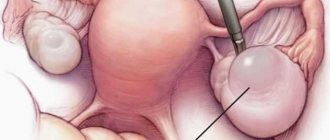Ovarian cyst is a fairly common disease that has different types; during pregnancy they behave differently. If some types are present, conception becomes impossible. If planning a child occurs against the background of a cyst, you definitely need to consult a qualified doctor.
Is it possible to get pregnant if you have an ovarian cyst?
It all depends on the location of the growth, whether one organ is affected or both. There are these types of cysts:
- corpus luteum;
- endometriotic;
- paraovaryl;
- follicular;
- dermoid;
- polycystic disease;
- malignant formations.
Such types of cysts as endometriotic and follicular can create great obstacles to conception. Pregnancy with paraovarian, dermoid cysts is permitted only if it does not tend to increase, and its size does not exceed 3 cm. And only the corpus luteum cyst is considered absolutely safe for the fetus, even moreover, it contributes to the formation of the embryo and its attachment to the wall of the uterus.
With a cyst of the right ovary
If only the right ovary is affected, the chances of successful conception are reduced by 50%. A follicular cyst, in the presence of which the egg cannot leave the follicle, does not contribute to conception. If it was formed only on the right female organ, then the egg during ovulation will come out of the left one after one cycle.
The endometrial type of formation creates unfavorable conditions for the origin of life. Even if it has formed on only one ovary, the formation can cause adhesions in the uterus and block the path of the fertilized egg to the uterus.
With a cyst of the left ovary
If there is one healthy female organ, conception is possible, since one of the two organs will be in working condition.
In addition, types of diseases such as paraovary and dermoid cysts do not prevent the release of the egg from the follicle, which means they do not interfere with conception. At the stage of planning a child, you must definitely come for a consultation with a doctor.
It happens that a woman has health problems and does not even know it. If a cystic bladder was detected during an examination of the female genital organs, it is worth undergoing treatment before conception.
If a malignant ovarian cyst is discovered during the examination, it should be removed immediately. Postoperative rehabilitation is incompatible with pregnancy.
If the cyst is on both ovaries
The ability to get pregnant largely depends on the type of cystic suture. A follicular cyst or polycystic disease on both ovaries makes a woman completely infertile. With medicinal, surgical treatment, and rehabilitation, conception is excluded. If there are malignant tumors on both the right and left sides, urgent surgery will be required. In particularly advanced cases, removal of the ovaries is not excluded.
As for safer formations when planning pregnancy: if the growth does not exceed 3 cm in size and does not increase, then with constant monitoring by a doctor, conception and gestation are not prohibited.
What types of cysts do not pose a threat to a pregnant woman?
In early pregnancy, a corpus luteum (luteal) cyst most often occurs. This type of neoplasm develops from the corpus luteum, which is necessary for the proper formation of the placenta. If the expectant mother has been diagnosed with this, there is no need to worry. A luteal cyst does not threaten pregnancy, does not increase in size, and resolves on its own after 12 weeks.
A paraovarian ovarian cyst and pregnancy do not interfere with each other until the tumor begins to grow. At the initial stage, constant monitoring is carried out. If the cyst begins to grow, surgical intervention is necessary.
Absolutely all cysts that are larger than 6 cm in diameter are removed.
Is it possible to get pregnant and give birth with an ovarian cyst?
From what is known about this disease, we can conclude that with certain types of it, the possibility of becoming pregnant is not excluded.
Does it interfere with getting pregnant?
Diseases such as polycystic disease, follicular and endometriotic formations make conception almost impossible, and if both organs are affected, the woman is considered infertile.
Does it affect conception?
In the presence of such types of blisters as paraovary and dermoid, nothing prevents the release of the egg from the follicle, as well as its passage into the uterus. Therefore, such formations do not affect conception in any way.
But if the presence of a formation on the female genital organs changes the hormonal levels, it becomes difficult to correctly determine the time of onset of ovulation. With hormonal imbalance, the days of menstruation may shift, accompanied by an abundance of blood and severe pain.
You need to be very careful if you have an endometriotic cyst. This disease causes processes in the uterus in which the embryo cannot reach it and attach to its walls. If you do get pregnant, it will be ectopic. It is worth getting rid of such a disease surgically at the stage of planning a child.
How does it affect an existing pregnancy?
A functional cyst and pregnancy are completely compatible concepts.
During the prenatal period, hormonal levels change, during which formation decreases. Until 16-20 weeks of pregnancy, the disease completely disappears.
Surgical treatment is required if we are talking about polycystic disease. Its proximity to pregnancy can lead to consequences such as miscarriage, fetal death and premature birth. If this syndrome is present, regular ultrasound monitoring is necessary. During fetal enlargement, the uterus puts pressure on the formation, which can have the following consequences:
- the vascular pedicle of the cyst is twisted;
- rupture of formation, hemorrhage.
The occurrence of abdominal pain, increased heart rate, nausea, fever, bleeding from the vagina - all this is an indication for immediate consultation with a doctor.
Impact on childbirth
If the formation increases by more than 5 cm during the prenatal period, the doctor will advise the woman to undergo surgery no earlier than 15-20 weeks of pregnancy. If this is not done, and the formation continues to increase, this will be an indication for a cesarean section.
Types of cystic neoplasms, their danger
The neoplasm becomes the source of numerous, serious problems in the female body:
- infertility (cyst develops against the background of lack of ovulation);
- menstrual irregularities (scanty, unsystematic discharge);
- sharp pain;
- external changes for the worse (weight changes, intense hair growth throughout the body, voice becomes rougher);
- a malignant tumor may appear.
The most common types are:
- follicular cyst;
- corpus luteum cyst;
- inflammatory cyst;
- polycystic ovary syndrome (PCOS);
- endometrioid cystic formation;
- large benign tumors.
A cyst from a neoplasm can evolve into an oncological disease. Surgical intervention in this case is mandatory.
Prevention of possible complications
It is worth getting rid of education before conception. With some types of disease, pregnancy cannot occur. In others it can, but during pregnancy it continues to grow, creating risks for the health of the baby and the expectant mother. There is a situation in which the bubble disappears as the fetus grows.
In any case, the doctor should monitor the condition and changes in the formation during pregnancy, and if the condition worsens, prescribe appropriate treatment or offer to remove the cyst surgically.
When planning a child with an ovarian cyst, constant medical supervision is required. Only he will be able to determine its type and predict how the formation will affect conception and gestation.
What cysts are dangerous during pregnancy?
As mentioned earlier, when a tumor reaches a large size, it not only begins to put pressure on neighboring organs, but also threatens the life of both mother and child.
The greatest danger is caused by formations of a cystic (cystadenoma) and endometriotic nature.
Depending on the contents, cystadenoma can be serous (liquid inside) and mucous (filled with thick mucus). This type of formation grows quite quickly and can reach up to 30 cm in diameter! An enlarged cystadenoma is accompanied by painful sensations in the lower abdomen. During early pregnancy, blood may appear.
Simultaneous development of the fetus and enlargement of the ovarian cyst
Endometrioid (chocolate) cyst occurs due to endometriosis. Contents are brown. Development is promoted by increased hormone levels. Since estrogen increases during pregnancy, the formation begins to grow. Threatens apoplexy (rupture). A pregnant woman experiences severe pain.
A neoplasm “on a stalk” also poses considerable danger. This type can cause ovarian torsion, which can lead to miscarriage.
Due to the large number of possible consequences, doctors carefully monitor the standing of the pregnant woman, and recommend that all women get rid of the disease before conception.
The influence of a neoplasm on the course of pregnancy
If you have problems conceiving, the cause may be a cystic formation on the ovary. Also, with hormonal imbalances, “rejection” reactions in the form of miscarriage are possible.
Such a specific disease as an ovarian cyst requires serious treatment. With a follicular cyst, there is a chance of conception. In the first trimester, it often resolves on its own due to its small size. Only with an increase in its size are complications possible. A neoplasm of the corpus luteum, when enlarged to a large size, can cause miscarriage. Childbirth with an ovarian cyst can provoke its rupture with subsequent complications in the form of infectious diseases.
The development of a neoplasm is associated with a lack of progesterone in a woman’s body. After a course of hormonal therapy, the patient's condition improves. To find out the reasons for the appearance of the cyst, it is necessary to conduct examinations and prescribe a course of treatment so that it is possible to become pregnant in the future.
With an endometrioid cyst, there is not a high chance of conception. Neoplasms are very dangerous and require surgical removal. Growing up to 25 cm, they are accompanied by painful sensations that are difficult to bear. When the tumor is large and can interfere with the normal development of pregnancy, a decision is made to remove it.
During surgery, only the cyst is removed; in most cases, the ovarian tissue is preserved. The procedure is performed in the second trimester of pregnancy.
WHAT IS LAPAROSCOPY AND HOW IS IT PERFORMED?
Laparoscopy is a way to operate on a diseased internal organ without cutting the abdominal wall, but only by making a small, neat incision, no more than 1.5 cm long. Obviously, through such a small hole it is simply impossible to get to the source of inflammation with a scalpel and other instruments from a standard surgical set . To do this, use a laparoscope - a thin flexible tube, hollow inside. It is equipped with a light source and a miniature video camera, the image from which is transmitted to the screen in the operating room.
The laparoscope has a hollow structure for a reason - special micro-instruments are inserted through the hole in the tube, with the help of which all the necessary manipulations are performed. To provide room in the abdominal cavity for maneuvers with the laparoscope, it is filled with carbon dioxide. That is, the stomach inflates like a balloon.
It must be said that laparoscopy is not always an operation, but sometimes a diagnostic method. If the patient’s condition worsens, but neither tests nor standard ultrasound can identify the cause, then the use of laparoscopy is fully justified. Such a diagnostic procedure will allow you to look into every corner of the abdominal cavity and see what is actually happening there.
Causes of cysts on the ovary during pregnancy
If an ovarian cyst is discovered during pregnancy, it could appear long before the fertilization of the egg; various factors could serve as the reasons for its development:
- hormonal disorders;
- following a strict diet for a long time;
- severe stress, anxiety;
- the patient is overweight;
- change in climatic conditions;
- dystrophy;
- prolonged hypothermia;
- bad habits;
- lack of physical activity;
- promiscuous sexual intercourse.
In each case, it is necessary to individually reconsider the factors influencing the reproductive organs and begin complex therapy. Also, an ovarian cyst can form during gynecological interventions, after an abortion, unqualified examination, installation of a contraceptive device, and much more.
An ovarian cyst during pregnancy can appear as a result of dysfunction of the thyroid gland, adrenal glands, and other organs that are responsible for the secretion of hormones.
Advanced gynecological disorders, poor lifestyle, early sexual intercourse, sex during menstruation, hypothermia, and sexual abstinence for a long time can affect the further development of the growth.











